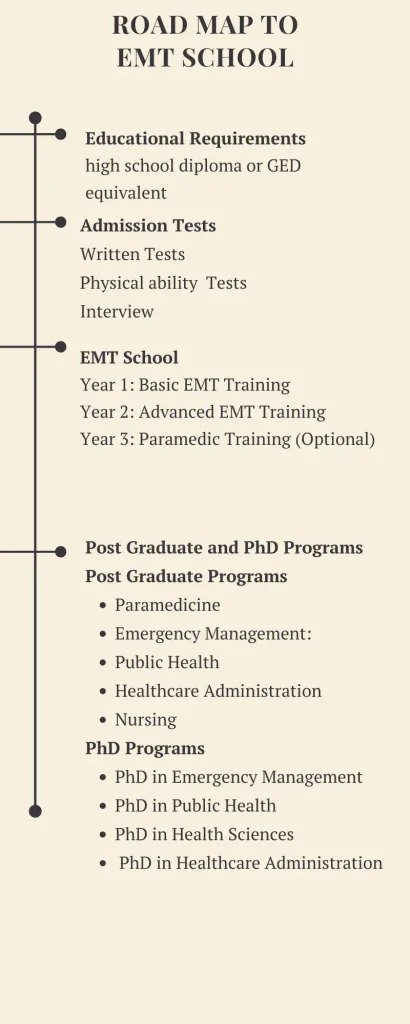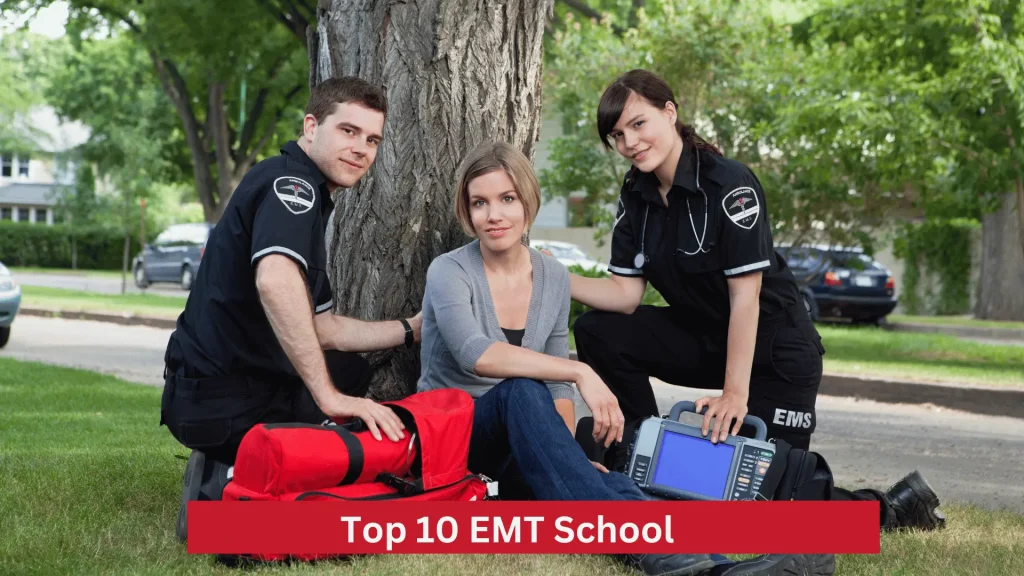How Long is EMT School
EMT school typically lasts between 6 months to 2 years, depending on the program and certification level. Basic EMT training can be completed in about 6 months, while advanced EMT and paramedic programs may take up to 2 years. Understanding “How Long is EMT School” helps prospective students plan their educational journey.
What is EMT School
EMT school provides the essential training needed to become an Emergency Medical Technician. The curriculum covers fundamental medical skills, emergency response techniques, and patient care. Students learn through a combination of classroom instruction, hands-on practice, and clinical rotations, preparing them to respond effectively to various medical emergencies in real-world scenarios.

How Long is EMT School
Year 1: Basic EMT Training
Duration: 6 months to 1 year
Content: Introduction to emergency medical services, basic life support skills, CPR, first aid, and patient assessment.
Clinical Rotations: Hands-on practice in hospitals or ambulance services.
Certification: Students may earn a Basic EMT certification upon completion.
Year 2: Advanced EMT Training
Duration: Additional 6 months to 1 year (if continuing)
Content: Advanced patient care techniques, intravenous therapy, advanced airway management, and pharmacology.
Clinical Rotations: More intensive hands-on practice and internships.
Certification: Students may earn an Advanced EMT certification upon completion.
Year 3: Paramedic Training (Optional)
Duration: 1 year
Content: In-depth study of advanced medical procedures, anatomy, physiology, and advanced pharmacology.
Clinical Rotations: Extensive internships in hospitals and on ambulances.
Certification: Students may earn a Paramedic certification upon completion.

How to Enter EMT School
Educational Requirements
High School Diploma or GED: Required for admission.
Prerequisite Courses: Basic courses in biology, anatomy, and physiology are often recommended or required.
CPR Certification: Must be obtained before starting the program.
Entry Tests for EMT School
Written Exam: Tests basic knowledge in math, reading comprehension, and science.
Physical Ability Test: Evaluates physical fitness and ability to handle the demands of the job.
Interview: Assesses communication skills and suitability for the EMT role.
Application Process for EMT School
Application Form: Complete the school’s application form.
Transcripts: Submit high school or previous college transcripts.
Recommendation Letters: Provide letters from teachers or professionals.
Personal Statement: Write an essay explaining why you want to become an EMT.
Application Fee: Pay a non-refundable fee.
Financial Aid for EMT School
Federal Aid: Apply for FAFSA to determine eligibility for grants, loans, and work-study programs.
Scholarships: Look for scholarships specific to healthcare or EMT training.
State Aid: Check for state-specific grants and financial assistance programs.
Payment Plans: Some schools offer payment plans to spread out tuition costs.
Employer Sponsorship: Some employers may sponsor education for employees pursuing EMT certification.
By understanding these components, prospective EMT students can better navigate the educational path and financial aspects of their training.
Postgraduate and PhD Programs for EMT School
While traditional EMT training typically does not extend to postgraduate or PhD levels, there are advanced education options for those looking to further their careers in emergency medical services or related fields.
Postgraduate Programs:
- Paramedicine: Advanced training in paramedic practices, often leading to a Master’s degree.
- Emergency Management: Focuses on preparing for and responding to emergencies, often at a Master’s level.
- Public Health: A Master’s in Public Health (MPH) with a focus on emergency medical services.
- Healthcare Administration: Master’s programs focusing on the management of healthcare facilities and services.
- Nursing: Advanced nursing degrees (e.g., MSN or DNP) with a focus on emergency or trauma nursing.
PhD Programs:
- PhD in Emergency Management: Research-focused programs on disaster response and emergency preparedness.
- PhD in Public Health: Specializations in epidemiology, biostatistics, or health policy with applications in emergency medical services.
- PhD in Health Sciences: Research and development of new techniques and technologies for emergency care.
- PhD in Healthcare Administration: Advanced studies in the administration and management of healthcare systems, including emergency services.
Top 10 EMT Schools

- University of Pittsburgh (PA)
The University of Pittsburgh offers a highly regarded EMT program that emphasizes both academic rigor and extensive clinical experience. Their Center for Emergency Medicine provides students with hands-on training and access to cutting-edge medical technology.
2. George Washington University (DC)
GWU’s Emergency Medical Services program is known for its comprehensive curriculum and innovative approach to EMT training. Students benefit from the university’s strong connections with local hospitals and emergency services.
3. University of California, Los Angeles (UCLA)
UCLA offers an outstanding EMT training program through its Center for Prehospital Care. The program includes rigorous coursework and practical training, ensuring graduates are well-prepared for the demands of the profession.
4. University of Texas Health Science Center at San Antonio (TX)
This institution provides an extensive paramedic training program with a strong emphasis on advanced clinical practice. Students gain experience through various rotations in hospitals and emergency services.
5. Creighton University (NE)
Creighton University is renowned for its EMS education programs, offering both EMT and paramedic courses. The program combines theoretical knowledge with hands-on practice in real-world settings.
6. St. John’s University (NY)
St. John’s University offers a robust EMS program that covers all aspects of emergency medical care. The curriculum includes both classroom instruction and practical experience in clinical environments.
7. Eastern Kentucky University (KY)
EKU’s EMS programs include degrees in emergency medical care and paramedic science. The university provides students with comprehensive training and numerous opportunities for hands-on learning.
8. University of Maryland, Baltimore County (MD)
UMBC is known for its excellent EMS programs, which include paramedic and emergency health services management courses. The program emphasizes both academic and practical skills necessary for a successful EMS career.
9. College of Southern Nevada (NV)
CSN offers a comprehensive EMT program with a strong focus on practical training and community involvement. Students receive extensive hands-on experience, preparing them for real-life emergency situations.
10. Tacoma Community College (WA)
TCC provides an extensive EMT program that focuses on hands-on training and real-world experience. The program is designed to equip students with the skills and knowledge needed to excel in the field of emergency medical services.
These schools are recognized for their exceptional EMT training programs, experienced faculty, and opportunities for hands-on learning, making them top choices for aspiring EMTs.
Factors Affecting the Length of EMT School
The duration of EMT school can vary significantly based on several factors. Understanding these factors can help prospective students choose the right program for their needs and goals.
1. Program Type
Basic EMT Program: Typically lasts 6 months to 1 year. This program covers fundamental skills such as CPR, first aid, and basic patient care.
Advanced EMT Program: Generally lasts an additional 6 months to 1 year beyond the Basic EMT training. It includes advanced procedures like intravenous therapy and advanced airway management.
Paramedic Program: Often takes 1 to 2 years to complete. This advanced program covers in-depth medical knowledge and advanced life-support techniques.
2. Program Format
Full-Time vs. Part-Time: Full-time programs are more intensive but shorter, typically lasting around 6 months to 1 year. Part-time programs may extend over 1 to 2 years due to less frequent class sessions.
Accelerated Programs: Some schools offer accelerated programs that can shorten the duration by compressing the schedule, though they may require a more intense commitment.
Hybrid Programs: Programs that combine online coursework with in-person labs or clinical experiences can vary in length depending on the student’s pace and schedule.
3. State Requirements
Certification Requirements: Each state has different requirements for EMT certification, which can affect the length of the program. States with more rigorous certification requirements may have longer programs.
Local Regulations: Some states or regions have additional training requirements or certifications that can extend the length of EMT school.
4. Course Load and Curriculum
Comprehensive vs. Basic Curriculum: More comprehensive programs that include a broader range of topics, such as extensive clinical hours or advanced medical techniques, will take longer to complete.
Clinical and Field Internships: Programs with extensive clinical and field internships may be longer due to the additional hours required for hands-on experience.
5. Instructor Experience and Program Quality
Experienced Instructors: Programs with highly experienced instructors might offer a more in-depth education, which could affect the duration of the training.
Quality of Facilities: Programs with state-of-the-art training facilities may offer more extensive and effective training, which can influence program length.
6. Student Background
Prior Experience: Students with prior healthcare experience may be able to complete the program more quickly due to their existing knowledge and skills.
Pre-Requisite Knowledge: Students who have completed pre-requisite courses or certifications may find that their program duration is shorter.
Final Verdict
Choosing the right EMT school involves understanding various factors that affect the length and quality of the program. By considering the type of program, format, state requirements, and personal commitments, you can select the best training path to achieve your career goals in emergency medical services.
FAQs
1. What is the difference between a Basic EMT and an Advanced EMT?
Answer: A Basic EMT provides fundamental emergency medical care, while an Advanced EMT offers more advanced skills, such as intravenous therapy and advanced airway management. Basic EMT training takes about 6 months, while Advanced EMT training can add another 6 months to 1 year.
2. How long does it take to become a paramedic?
Answer: Becoming a paramedic typically takes 1 to 2 years. The program includes advanced medical training, clinical rotations, and field internships, building on the skills learned as a Basic or Advanced EMT.
3. What are the educational requirements for entering EMT school?
Answer: You need a high school diploma or GED to enter EMT school. Some programs also recommend or require courses in biology, anatomy, and CPR certification before admission.
4. Are there financial aid options available for EMT school?
Answer: Yes, financial aid options include federal grants, state scholarships, and payment plans. You can apply for FAFSA, seek scholarships specific to EMS, or check for state-based financial assistance.
5. What types of certifications can I earn from EMT school?
Answer: From EMT school, you can earn certifications such as Basic EMT, Advanced EMT, and Paramedic, depending on the program level. Each certification has specific requirements and represents different levels of medical expertise and responsibility.
